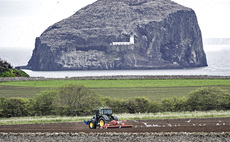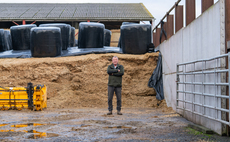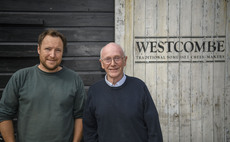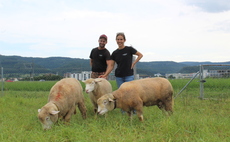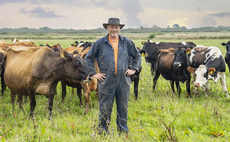The shift to more sustainable methods of crop production is gathering pace and one estate owner believes independent advice has been key in a successful transition to his emissions-busting regenerative system. Ãļ§Ö±²¥ reports.
Regenerative agriculture is a growing movement and independent advice is set to become increasingly important for arable farms transitioning to such a system, as shown by the experience of Leicestershire estate owner Hylton Murray-Philipson.
After inheriting the indebted 400-hectare Blaston Estate at 21, Mr Murray-Philipson went to work in investment banking to improve its finances, initially in London, then Brazil and New York.
Having always had an interest in environmental conservation, his eyes were opened to the human impact on ecosystems when in Brazil, witnessing first-hand the destruction of the Amazon rainforest for the expansion of soya production.
After returning home full-time, he observed his topsoil disappearing in flash floods and lifeless soil underneath the wheat-oilseed rape-wheat rotation it supported, and thought there must be a better way of managing the farm for future generations.
This set him off on a journey into what is now labelled regenerative agriculture, with independent agronomy group Indigro providing help and guidance since his moment of clarity.
Speaking at the Association of Independent Crop Consultants (AICC) annual technical conference, he said: I think having independent advice is essential and logical [for regenerative farming], as it needs to be separated from those which are fundamentally carving a living from input sales.
Almost more important, though, is the individual. They must be open-minded and on board for a journey towards a long-term objective.
Whilst financial viability is an essential component of sustainability, its good to set soil condition and increased biodiversity as the key long-term objectives, rather than focus exclusively on yield and short-term profit.
Since 2007, his rotation evolved from the two crops to the more diverse six crops planted today, including two spring-sown options and rotational grass leys that have supported the reintroduction of livestock. His aim is to end up with a 50:50 split of rotational grass and arable.
The land is no longer ploughed, with crops either established with very minimal cultivation or direct drilled.
Worm numbers have increased from seven per sq.m to 50/sq.m during transition and soil organic carbon has been increased significantly over a similar period, right across the farm.
As the Basic Payment Scheme is phased out, this leaves the business well placed to take advantage of the Environmental Land Management (ELM) scheme and the potential to generate carbon credits.
Hopefully its something we can monetise in the future, said Mr Murray-Philipson.
Indigro adviser and AICC Academy member Charlotte Cook has been advising the estate over recent seasons and looking closely at measuring and reducing the farms emissions, potentially facilitating that monetisation.
Along with measures to increase soil carbon, reducing emissions is key to net zero goals and any reductions will almost exclusively stem from reducing inputs.
She said: I think as independent advisers we are best placed to help farmers do that.
Ms Cook said there are several free tools to help businesses measure carbon, all with pros and cons. She has used the Cool Farm Tool to investigate the carbon emissions for each crop enterprise at Blaston and identify where cuts might be made.
All the tools require similar data input, including harvested yields, fertiliser and pesticide use, energy use, transport costs on and off farm and physical measurements of soil carbon from field sampling.
All crops in the rotation were assessed, with data imported from crop recording software and long-term soil carbon monitoring results.
As would be expected, emissions varied between crops, but due to the many practices introduced in the farms arable system, all were net sequesterers of carbon.
Its really exciting and the two fields in transition to a regenerative system the longest had the lowest total emissions as they had the highest sequestration figures, said Ms Cook.
She said measuring soil carbon is going to become a key part of holistic farm management, evident from its addition as a qualifier for payments as part of ELM.
It also has the potential to be a good news story for agriculture, showing that the arable industry can produce food in a sustainable way, while having a positive impact on climate change.
Despite the positive sustainability assessment, there are areas where improvements can be made, most notably in nitrogen use, which accounts for about 50% of the estates emissions.
Ms Cook is working with the farm to understand how establishing a permanent white clover understory might help reduce N inputs. In theory, it provides a permanent nitrogen-fixing cover which cash crops are direct drilled into each year.
Additional benefits include a reduction in soil erosion and diffuse pollution and encouraging increases in soil biology.
A split field trial was set up in 2020-21 and showed that while there was a small reduction in yield, the understory allowed a significant reduction in N input and any hit was economically viable.
I think as the clover matures and we hone our understanding of permanent understories, it will provide more nitrogen, enabling us to further reduce synthetic fertiliser applications without an impact on yield, potentially increasing profitability.
Key learnings from Blastons transition to regenerative ag
- It doesnt happen overnight formulate a 10-year plan
- Be clear on aspirations between farmer and adviser
- Set baselines for key measures of success from the start
- Independent advice is key in reducing inputs/emissions
- Reducing inputs may increase risk be honest about it
- Analyse cost-benefit of all changes to ensure sustainability






